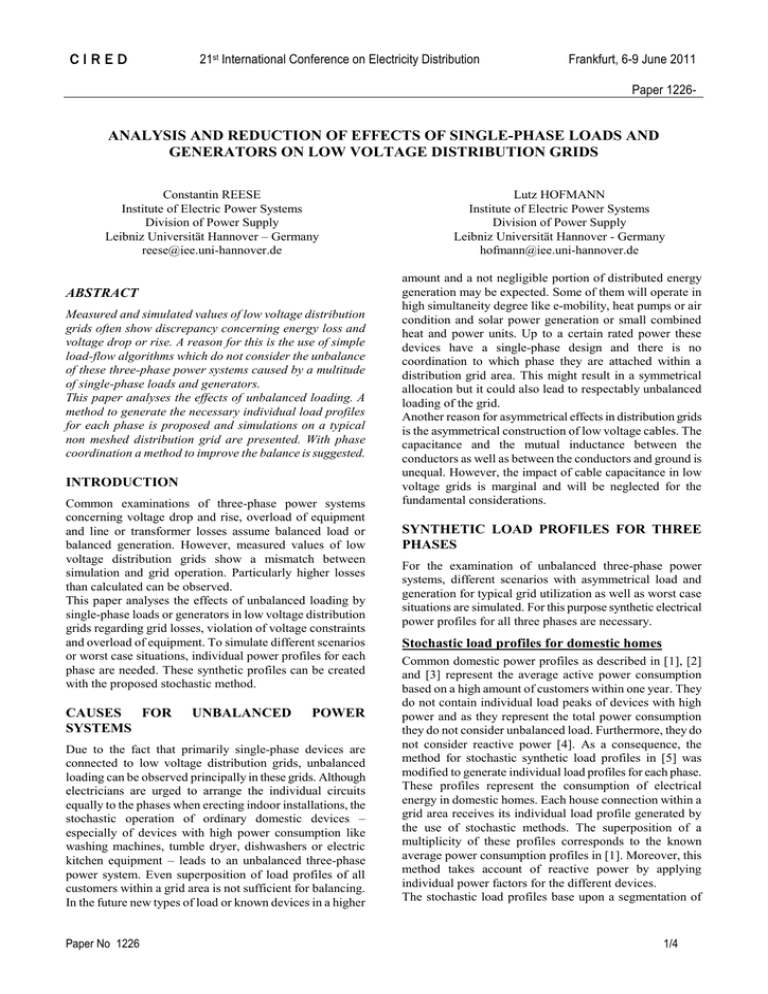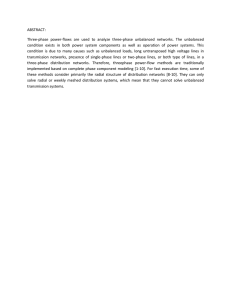Analysis and Reduction of Effects of Single
advertisement

CIRED 21st International Conference on Electricity Distribution Frankfurt, 6-9 June 2011 Paper 1226- ANALYSIS AND REDUCTION OF EFFECTS OF SINGLE-PHASE LOADS AND GENERATORS ON LOW VOLTAGE DISTRIBUTION GRIDS Constantin REESE Institute of Electric Power Systems Division of Power Supply Leibniz Universität Hannover – Germany reese@iee.uni-hannover.de ABSTRACT Measured and simulated values of low voltage distribution grids often show discrepancy concerning energy loss and voltage drop or rise. A reason for this is the use of simple load-flow algorithms which do not consider the unbalance of these three-phase power systems caused by a multitude of single-phase loads and generators. This paper analyses the effects of unbalanced loading. A method to generate the necessary individual load profiles for each phase is proposed and simulations on a typical non meshed distribution grid are presented. With phase coordination a method to improve the balance is suggested. INTRODUCTION Common examinations of three-phase power systems concerning voltage drop and rise, overload of equipment and line or transformer losses assume balanced load or balanced generation. However, measured values of low voltage distribution grids show a mismatch between simulation and grid operation. Particularly higher losses than calculated can be observed. This paper analyses the effects of unbalanced loading by single-phase loads or generators in low voltage distribution grids regarding grid losses, violation of voltage constraints and overload of equipment. To simulate different scenarios or worst case situations, individual power profiles for each phase are needed. These synthetic profiles can be created with the proposed stochastic method. CAUSES FOR SYSTEMS UNBALANCED POWER Due to the fact that primarily single-phase devices are connected to low voltage distribution grids, unbalanced loading can be observed principally in these grids. Although electricians are urged to arrange the individual circuits equally to the phases when erecting indoor installations, the stochastic operation of ordinary domestic devices – especially of devices with high power consumption like washing machines, tumble dryer, dishwashers or electric kitchen equipment – leads to an unbalanced three-phase power system. Even superposition of load profiles of all customers within a grid area is not sufficient for balancing. In the future new types of load or known devices in a higher Paper No 1226 Lutz HOFMANN Institute of Electric Power Systems Division of Power Supply Leibniz Universität Hannover - Germany hofmann@iee.uni-hannover.de amount and a not negligible portion of distributed energy generation may be expected. Some of them will operate in high simultaneity degree like e-mobility, heat pumps or air condition and solar power generation or small combined heat and power units. Up to a certain rated power these devices have a single-phase design and there is no coordination to which phase they are attached within a distribution grid area. This might result in a symmetrical allocation but it could also lead to respectably unbalanced loading of the grid. Another reason for asymmetrical effects in distribution grids is the asymmetrical construction of low voltage cables. The capacitance and the mutual inductance between the conductors as well as between the conductors and ground is unequal. However, the impact of cable capacitance in low voltage grids is marginal and will be neglected for the fundamental considerations. SYNTHETIC LOAD PROFILES FOR THREE PHASES For the examination of unbalanced three-phase power systems, different scenarios with asymmetrical load and generation for typical grid utilization as well as worst case situations are simulated. For this purpose synthetic electrical power profiles for all three phases are necessary. Stochastic load profiles for domestic homes Common domestic power profiles as described in [1], [2] and [3] represent the average active power consumption based on a high amount of customers within one year. They do not contain individual load peaks of devices with high power and as they represent the total power consumption they do not consider unbalanced load. Furthermore, they do not consider reactive power [4]. As a consequence, the method for stochastic synthetic load profiles in [5] was modified to generate individual load profiles for each phase. These profiles represent the consumption of electrical energy in domestic homes. Each house connection within a grid area receives its individual load profile generated by the use of stochastic methods. The superposition of a multiplicity of these profiles corresponds to the known average power consumption profiles in [1]. Moreover, this method takes account of reactive power by applying individual power factors for the different devices. The stochastic load profiles base upon a segmentation of 1/4 CIRED 21st International Conference on Electricity Distribution Frankfurt, 6-9 June 2011 Paper 1226- 2500 active power Pload in W phase L1 2000 phase L2 phase L3 1500 1000 500 0 0 6 12 time in hours 18 24 Figure 1. Stochastic three-phase load profiles for domestic homes Table 2. Classification of consumer devices Class Base load Medium power High power Paper No 1226 Devices refrigerator, freezer, circulation pump in heating installations, stand-by consumers, low power devices electric lightning, entertainment electronics electric cooker and oven, dishwasher, washing machines, tumble dryer Generation profiles for solar power plants For the examination of unbalanced feeding of distributed energy generation, profiles are necessary as well. For the photovoltaic generation profile a measured time series of a solar power plant at Leibniz Universität Hannover is transferred to a standardized profile with 15-minute-steps. The profile represents the fed power of a solar power plant with a rated power of 1 kW located in northern Germany. Figure 2 shows its average power per day within one year. 300 active power Psolar in W domestic load into consumer classes: base load, high power devices and medium power devices. High rated power devices which are normally operated only for short duration are not taken into account as they have no effect on average profiles with 15-minute-steps. The assignment of devices to the classes is shown in table 2. The profiles contain 15-minute average values. Weekdays and public holidays are considered as well as the time of sunrise and sunset, average temperature and light intensity and the difference in equipment of the domestic homes. The individual equipment for each household is determined stochastically and includes whether the devices in table 2 exist and which power consumption they have. Furthermore, it is distinguished between working and non-working households as well as between apartments and houses. The stochastic synthetic load profiles created with this method describe the individual total power consumption of each customer in a grid area for all three phases together. To receive load profiles for each phase separately, a modification of this method is necessary. At the generation of the profiles it will initially be decided which stationary device is connected to which phase. Thereby some dependencies have to be regarded. If a tumble dryer is present, it is connected to another phase than the washing machine with high probability but not definitely. A high amount of modern three-phase cookers use two phases for the cooking plates and one phase for the oven. According to this, the power consumption for cooking has to be split up stochastically to the single phases. Figure 1 shows an example of a domestic load profile for each phase of a three-phase power system for the duration of one day. 250 200 150 100 50 0 50 100 150 200 250 time in days 300 350 Figure 2. Generated power of a solar power plant with 1 kW rated power (daily average values) In Germany distributed energy generators with a maximum rated power of 4.6 kVA may be connected to a single-phase. For solar power plants this limit is 5 kW [6]. As this paper relates to asymmetrical loading the rated power of the simulated solar power plants is limited to 5 kW. They are stochastically arranged to the house connections within the grid area and are connected to one phase only. The allocation to one of the phases occurs at random. Load profiles for charging of electric vehicles As example for new types of load the charging procedure of electric vehicles is considered. Since the charging particularly at low power takes a few hours depending on the driven distance, a high degree of simultaneity can be expected when employed residents of a grid area start charging their cars in the afternoon respectively evening. To examine the effects of unbalanced loading, only charging devices with single-phase design are regarded in this paper. In indoor installations with a rate voltage of 230 V and a 16 A fuse protection a maximum single-phase power of 3.6 kW can be obtained in one circuit. The electric vehicles for the simulations in this paper have a constant rated charging power of 3 kW and the beginning and the duration of charging are defined stochastically within reasonable constraints. The charging procedures begin between 16:00 and 19:00 and the duration is between three and five hours. The electric cars are allocated stochastically to the households and the phase to which its charging unit is connected is chosen at random. 2/4 CIRED 21st International Conference on Electricity Distribution Frankfurt, 6-9 June 2011 Paper 1226- HIGHER POWER LOSSES BY UNBALANCED LOADING As the power loss depends quadratically on the current, a higher load and consequently a higher current on one phase leads to respectively higher losses in the system, though the active power usage at the resistors is approximately the same. On the basis of the simple exemplary configuration shown in figure 3 the impact of unbalanced loading on power loss is demonstrated. Via transformer a low voltage cable for distribution grids with a length of 250 m is connected to a three-phase power source with constant voltage. On the other end 9 similar resistor represent the load. They are allocated variably to the three phases. transformer 20 kV cable load whole load is connected to one phase only compared with balanced loading. The effective power at the load node in this case is still about 82 %. EFFECTS OF UNBALANCED LOADING IN LOW VOLTAGE DISTRIBUTION GRIDS On the basis of a typical low voltage distribution grid the impacts of unbalanced loading are pointed out. The exemplary non meshed grid supplies 75 domestic homes. It is connected to the medium voltage level by a transformer with 400 kVA rated power. Due to the consideration of the cables between the house connections and the sleeves to the main cables the grid comprehends 154 nodes which are sectioned in four strings. Figure 4 shows the network plan in which the nodes of house connections are represented by the arrowheads. 0,4 kV PLoad scource ground variable allocation Figure 3. Exemplary configuration Table 2. Effect of unbalanced loading to power losses for the exemplary configuration ∑ Pload Ploss, cable Ploss, trans. 3x 100,00 % 100,00 % 100,00 % 3x 2x 99,30 % 105,97 % 101,28 % Scenarios for simulation of unbalanced loading 2x 2x 97,95 % 117,29 % 103,71 % 5x 3x 1x 97,19 % 123,94 % 105,14 % 5x 4x 94,96 % 143,95 % 109,44 % 7x 1x 91,93 % 166,99 % 114,38 % 7x 2x 91,10 % 174,37 % 115,97 % 82,14 % 246,42 % 131,44 % For the simulations a multitude of scenarios were developed. The results of the following selection will be presented in this section: Scenario 1: 1st set of individual load profiles for 75 domestic homes Scenario 2: 2nd set of individual load profiles for 75 domestic homes Scenario 3: 3rd set of individual load profiles for 75 domestic homes Scenario 4: load profiles for households as in scenario 3 but with 1st set of 10 PV plants and 10 electric vehicles Scenario 5: load profiles for households as in scenario 3 but with 2nd set of 10 PV plants and 10 electric vehicles Scenario 6: load profiles for households as in scenario 3 but with 1st set of 20 PV plants and 20 electric vehicles Loading L1 L2 L3 3x 3x 4x 5x 9x 1x The results in table 2 demonstrate how the power losses increase according to the degree of unbalance. The power sources with constant voltage and the rising current in the phases which are loaded more intensive lead to a higher voltage drop at the load node. Due to this the effective power of the loads decreases slightly. However, the power losses grow considerably about 246 % in the cable when the Paper No 1226 Figure 4. Network plan of exemplary grid 3/4 CIRED 21st International Conference on Electricity Distribution Frankfurt, 6-9 June 2011 Paper 1226- Scenario 7: load profiles for households as in scenario 3 but with 2nd set of 20 PV plants and 20 electric vehicles All scenarios are simulated with a simple load-flow algorithm which does not consider unbalance and with a multi-phase load-flow algorithm which takes account of individual loads on each phase. The effective power at the customers is equal within a scenario and independent of the algorithm. Results of simulations with unbalanced loading The annual energy loss for the two methods of calculation is given in table 3 as well as the percentage deviation. Furthermore the number of violations of voltage constraints at all nodes together within one year is presented. Due to the 15-minute-steps of the profiles and the quantity of nodes, this value can theoretically reach a maximum of 5361120. Table 3. Impact of unbalanced loading to energy loss and violation of voltage constraints Scenario Energy loss MWh/year bal. Deviation unbal. Violations of voltage constraints bal. unbal. Scenario 1 6.20 6.43 3.70 % 0 314 Scenario 2 6.34 6.56 3.44 % 0 357 Scenario 3 6.12 6.35 3.64 % 0 266 Scenario 4 5.38 5.80 7.92 % 18 3391 Scenario 5 3.23 3.67 13.81 % 5 1415 Scenario 6 6.16 7.01 13.80 % 0 930 Scenario 7 8.21 8.81 6.97 % 0 479 bal.: simple load-flow algorithm for balanced loading unbal.: multi-phase load-flow algorithm for unbalanced loading The results in table 3 reveal that unbalanced loading leads to higher power losses and hence to higher energy losses than calculated with balanced loads or with an algorithm which does not take asymmetrical impedance into account. Furthermore, violations of voltage constraints are discovered by using a multi-phase load-flow algorithm. The differences in scenario 4 and 5 respectively 6 and 7 result from the varying arrangement of solar power plants an electric cars within the grid and the allocation of the phases. METHOD TO REDUCE UNBALANCE IN DISTRIBUTION GRIDS To lower the effects of unbalanced loading caused by single-phase loads and generators with high power, the possibility of phase coordination is proposed. When a new solar power plant or a power outlet for an electric vehicle with single-phase design should be connected to the indoor installation, the electrician sends a request to the local utility to which phase this device should be allocated. The utility checks the actual situation in the affected grid area and determines the phase on which a single-phase load or generator improves the balance most. This function could be integrated in commercial power Paper No 1226 system analysis tools. Subsequently, the electrician is instructed to use this phase for the new device. For this method the utilities have to expand their customer databases in order to store information about the phase allocation of these devices. Moreover, the arrangement of the phases at the house connections has to be defined exactly. To enforce these requests, an appropriate adjustment of the grid codes for low voltage distribution grids appears necessary. CONCLUSION Low voltage distribution grids supply primary single-phase devices. Some of the already existing and prospective distributed energy generators and high power loads are also single-phase designed. An asymmetrical allocation of these devices to the phases of a three-phase power system leads to an unbalanced loading. As common examinations do not consider this, measured values show a mismatch between simulation and operation. To simulate unbalanced grids, adequate synthetic load profiles are needed. A method to generate individual stochastic load profiles for each phase is introduced. In this paper the impact of unbalanced loading on power losses and voltage drop and rise are described. The presented results emphasize the deviation in simulations between a multi-phase and a simple single-phase load-flow algorithm. By ignoring the unbalance, a certain proportion of energy loss and violations of voltage constraints remain undetected. To improve the balance in distribution grids a method for phase coordination is suggested. This requires an extension of the utilities databases and adjustment of grid codes. REFERENCES [1] H. Meier, 1999, Repräsentative VDEW-Lastprofile, VDEW, Frankfurt, Germany. [2] D. Gerbec, S. Gasperic, F. Gubina, 2003, "Determination and Allocation of Typical Load Profiles to the Eligible Consumers", Proceedings of the IEEE Power Tech 2003. [3] M. Gavrilas, V.C. Sfintas, M.N. Filimon, 2001, "Identifying Typical Load Profiles Using NeuralFuzzy Models", IEEE PES transactions on Transmission and Distribution, vol.1. [4] M. Wolter, 2008, "Reactive Power Profiles“, Proceedings of the 8th WSEAS International Conference on Power Systems (Power’08). [5] B. Hühnerbein, C. Reese, Lutz Hofmann, 2008, "Stochastisches Lastmodell", Tagungsband zum 2. Statusseminar des FEN, 119-128. [6] 2001 / 2005, Eigenerzeugungsanlagen am Niederspannungsnetz, VDEW, Frankfurt, Germany. 4/4


